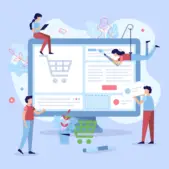The Internet of Things (IoT) is here, but it has not yet matured into a mainstream technology. As one of the biggest emerging trends in the technology world, it’s only a matter of time before enterprising problem-solvers address and correct the biggest challenges standing in IoT’s way.
Many of these problems represent significant shifts in the way people interact with technology. Without robust 5G network infrastructure, for instance, powering IoT devices and communicating with them reliably will remain out of reach.
Security concerns and government regulation will also play a pivotal role. But there is another key aspect of IoT implementation that isn’t getting as much headline space as these big-ticket items: UX design.
Whenever systems become more complex, the user experience (UX) suffers, even if the new complexity represents enormous value. Simplifying these processes without careful UX consideration can lead to unhappy customers and even catastrophic losses.
Case-in-Point: Data Recovery in the 2000s
If we assume the IoT revolution will at least be functionally similar to the dot-com boom of the ‘90s, and the rise of cloud technology in the ‘00s, it’s easy to see where pain points can creep in. The intersection of engineering complexity and design simplicity can create situations that harm users more than helping them.
Consider one of the most popular services for synchronizing files across multiple devices in the early ‘00s; this service, which shall remain nameless, was radically complex for its time, and offered an impressively simple user interface (UI).
But the service did not understand how to treat users who were used to physical storage media. If a user deleted a file on the service from one device, the file disappeared from all devices.
From an engineering point of view, it’s a great system – everything is always in sync. From a UX point of view, it’s an accident waiting to happen.
What UX Has to Teach Us About IoT
IoT has enormously transformative potential. Because of that potential, there will be hundreds of different services competing for users and offering wildly different experiences in the process.
IoT wearables have already grown into a $3 billion market. Almost all of these products involve innovative technology for which no clear UX standards yet exist – like search engines in the ‘90s and cloud technology in the ‘00s.
UX design tells us these products have to perform valuable services in order to remain economically viable. But now, more than ever, those services have to be intuitive, with a practically non-existent learning curve.
If a consumer experiences something useful and intuitive, it’s highly likely this experience will form the basis of a new routine or lifestyle. If that same experience is difficult, complicated, or even just mildly challenging, you can forget about mass adoption.
This means designers must prioritize simple, passive engagement. Decision fatigue is real, and the more IoT devices enter the market, the more engagement will suffer when there are no clear, no-brainer motivations to continue using products or services.
This is why almost all of the first-generation wearable tech products are undergoing a decline. The appeal of smart clothes and glasses has waned by 16 and 33 percent, respectively. Even fitness devices, which occupy the most obvious value-oriented device category in consumer IoT electronics, have registered declining daily wear rates.
Making IoT Work From a UX Point of View
In order for IoT to make good on its promise to transform the way human beings interact with technology, developers need to keep a few crucial UX considerations in mind. UX designers have spent a great deal of time and energy discovering these truths, and those who pay attention to them will stand to gain the most in tomorrow’s IoT tech market:
- Help people achieve their goals. This seems like a simple enough piece of advice, but the next time you use your smart watch, smartphone, or smart-anything, ask yourself how that particular interaction helped you achieve your goal. The IoT products that take off will be those that demonstrate how they help users achieve their goals with every single interaction.
- Get to “wow” as fast as possible. People don’t have the patience or attention spans they used to. Your product needs to produce a “wow” moment as quickly and as easily as possible to encourage long-term adoption.
- Focus on incentive. It’s easy to see why early IoT fitness wearables haven’t been the game-changing devices they were hyped up to be. Ninety percent of people quit the gym within three months – every single one of them will quit their fitness tracker at the same time. UX designers need to produce an experience that will motivate users to keep using them.
The developers, engineers, and business leaders that pay attention to these three UX elements when creating innovative IoT products will have a distinct competitive advantage in tomorrow’s market.


